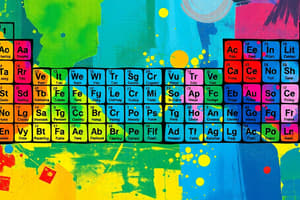Podcast
Questions and Answers
What determines the position of an element in a period?
What determines the position of an element in a period?
- Number of valence electrons (correct)
- Number of protons
- Atomic mass
- Number of neutrons
What feature makes elements in the same group have similar chemical properties?
What feature makes elements in the same group have similar chemical properties?
- Atomic mass
- Valence shell configuration (correct)
- Number of neutrons
- Period number
Which elements always occupy the rightmost position in their respective periods?
Which elements always occupy the rightmost position in their respective periods?
- Transition metals
- Noble gases (correct)
- Halogen elements
- Alkali metals
In the modern periodic table, how many elements are present in the fourth period?
In the modern periodic table, how many elements are present in the fourth period?
In the periodic table, which element starts the first period?
In the periodic table, which element starts the first period?
Why are elements in the same group referred to as a family?
Why are elements in the same group referred to as a family?
Which group is composed of alkali metals?
Which group is composed of alkali metals?
What distinguishes transition elements from normal elements?
What distinguishes transition elements from normal elements?
What is the significance of the Periodic Law in relation to the Periodic Table?
What is the significance of the Periodic Law in relation to the Periodic Table?
How does the shielding effect influence periodic trends?
How does the shielding effect influence periodic trends?
In the Periodic Table, how are the transition elements classified?
In the Periodic Table, how are the transition elements classified?
What is the main characteristic of alkali metals in terms of their valence shell configuration?
What is the main characteristic of alkali metals in terms of their valence shell configuration?
Flashcards
Element's position in a period?
Element's position in a period?
Determined by the number of valence electrons an element has.
Group's similar chemical properties?
Group's similar chemical properties?
Elements in the same group share similar chemical properties due to their identical valence shell configuration.
Rightmost elements in a period?
Rightmost elements in a period?
Noble gases always occupy the rightmost position in their respective periods.
Elements in the fourth period?
Elements in the fourth period?
Signup and view all the flashcards
First element, first period?
First element, first period?
Signup and view all the flashcards
Elements in the same group?
Elements in the same group?
Signup and view all the flashcards
Group of alkali metals?
Group of alkali metals?
Signup and view all the flashcards
Transition elements vs. normal elements?
Transition elements vs. normal elements?
Signup and view all the flashcards
Significance of the Periodic Law?
Significance of the Periodic Law?
Signup and view all the flashcards
Shielding effect on atomic size?
Shielding effect on atomic size?
Signup and view all the flashcards
Location of transition elements?
Location of transition elements?
Signup and view all the flashcards
Study Notes
Periodic Table Structure
- The position of an element in a period is determined by its atomic number, with elements arranged in order of increasing atomic number.
- The number of electrons in the outermost energy level (valence shell) determines the position of an element in a group.
Similar Chemical Properties
- Elements in the same group have similar chemical properties due to the same number of electrons in their outermost energy level.
Periodic Table Characteristics
- Noble gases always occupy the rightmost position in their respective periods.
- The fourth period in the modern periodic table contains 18 elements.
- The first period starts with Hydrogen.
Element Groups
- Elements in the same group are referred to as a family because they exhibit similar chemical properties due to the same number of electrons in their outermost energy level.
- Group 1 is composed of alkali metals.
Transition Elements
- Transition elements are distinguished from normal elements by their ability to form ions with different charges.
- Transition elements are classified as d-block elements in the Periodic Table.
Periodic Law and Trends
- The Periodic Law states that elements with similar chemical properties recur at regular intervals when elements are arranged in order of increasing atomic number.
- The Periodic Law is significant in relation to the Periodic Table because it allows for the prediction of an element's properties based on its position in the table.
- The shielding effect influences periodic trends by reducing the effective nuclear charge, resulting in decreased electronegativity and increased atomic radius down a group.
Alkali Metals
- The main characteristic of alkali metals is that they have a single electron in their valence shell, making them highly reactive.
Studying That Suits You
Use AI to generate personalized quizzes and flashcards to suit your learning preferences.




